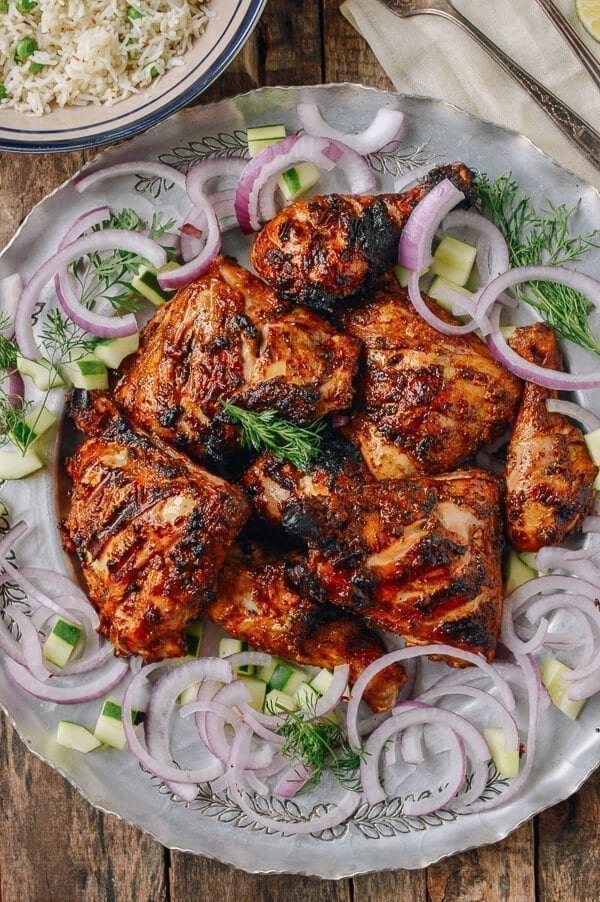Indian Tandoori Chicken: History, Recipe, Pairings & Health Benefits
Indian Tandoori Chicken traces its roots to the Mughal era. The dish’s name comes from the Persian word “tannūr,” meaning clay oven. This style of cooking gained prominence in the Punjab region, where restaurants employed traditional clay ovens, or tandoors, for preparing meats. Tandoori Chicken soon became a staple at many eateries in Lahore before spreading across the Indian subcontinent.
Evolution of the Recipe
Initially, the recipe for Tandoori Chicken involved just a few key ingredients: chicken, yogurt, and basic spices. Over time, chefs began incorporating a blend of spices like ginger, garlic, garam masala, and cayenne pepper, creating the complex flavor profile known today. Modern variations may include different marinades, cooking techniques, and even vegetarian adaptations, showcasing the dish’s versatility.
Essential Ingredients for Tandoori Chicken
Choosing the Right Chicken
Selecting quality chicken is crucial for authentic tandoori chicken. Opt for skinless chicken pieces—thighs, drumsticks, or breasts—ensuring they are fresh and free from any off smells. Bone-in pieces retain more moisture and flavor during cooking. If you prefer quicker cooking times, use boneless cuts but marinate them longer to infuse flavor deeply.
Key Spices and Marinades
Spices and marinades define tandoori chicken’s signature taste. Here’s a list of key ingredients you need:
- Yogurt: Acts as a tenderizer and base for the marinade. Use thick, whole-milk yogurt for richer flavor.
- Ginger and garlic paste: Provides a robust, aromatic foundation. Freshly made paste offers the best results.
- Garam masala: A blend of spices like cumin, coriander, and cardamom. Adds warmth and complexity.
- Turmeric: Gives the chicken its vibrant yellow color. Also, adds earthiness.
- Cayenne pepper: Contributes heat. Adjust the quantity according to your spice tolerance.
- Paprika: Adds mild heat and deep red color. Smoked paprika imparts a slight smokiness.
- Lemon juice or vinegar: Adds acidity to balance flavors and tenderize the meat.
- Salt: Essential for seasoning and enhancing other flavors.
- Oil: Helps in better marinade adherence and keeps the meat moist.
For an authentic flavor, ensure each ingredient is fresh and of high quality. By following these guidelines, you’ll replicate the traditional taste of tandoori chicken in your kitchen.
Cooking Techniques for Authentic Flavor
Traditional Tandoor Oven vs. Modern Alternatives
Using a traditional tandoor oven imparts a unique smoky flavor to Tandoori Chicken, achieved through high temperatures and the clay oven’s heat retention. Built from clay, these ovens reach up to 900°F, ensuring that the chicken cooks quickly while retaining moisture. If a tandoor oven isn’t available, you can use modern alternatives like a conventional oven or a grill.
Conventional ovens, set to 450°F, effectively mimic the high heat of a tandoor. Position the chicken on a rack inside a roasting pan to allow even air circulation. For an open-flame experience, a charcoal or gas grill works well. Preheat the grill to medium-high heat, approximately 450°F, and use indirect heat by placing the chicken on the grill’s cooler side. This method, though not identical, achieves a similar flavor profile.
Marinating and Cooking Times
Proper marination is essential for achieving authentic Tandoori Chicken flavor. Marinate the chicken for at least 6 hours, though an overnight marination is ideal. This ensures the spices penetrate deep into the meat, resulting in a flavorful dish. Use Greek yogurt, ginger-garlic paste, garam masala, turmeric, cayenne pepper, paprika, lemon juice, and salt in your marinade.
Cooking times vary based on the method. For a conventional oven, bake the marinated chicken for 25-30 minutes, turning halfway through. If using a grill, cook for 20-25 minutes, flipping occasionally to avoid burning. Ensure the internal temperature of the chicken reaches 165°F using a meat thermometer to confirm it is thoroughly cooked. By following these guidelines, you’ll replicate the traditional taste of Tandoori Chicken in your kitchen.
Pairings and Serving Suggestions
Accompaniments and Side Dishes
Pairing Tandoori Chicken with the right accompaniments enhances the dining experience. Bread options like naan, roti, or paratha provide a soft contrast to the smoky, spicy flavors of the chicken. Rice dishes, including biryani or plain basmati rice, offer a neutral base that complements the robust spices.
Vegetables make excellent side dishes, particularly those that balance the spice. Raita, a yogurt-based dish with cucumber and mint, cools the palate. Salads incorporating ingredients like onions, tomatoes, and cilantro add fresh, crisp notes. Chutneys, such as mint or tamarind, bring a tangy sweetness that contrasts the spiciness of the chicken.
Wine and Beverage Pairings
Selecting the right beverage elevates the meal. For wine, consider options with well-balanced acidity and slightly sweet notes. Off-dry Rieslings or Gewürztraminers complement the spices without overwhelming the taste. Sparkling wines add a refreshing touch that cleanses the palate between bites.
Beer is another popular choice. Opt for light lagers or wheat beers to counteract the heat, or go for a hoppy IPA to match the intensity of the dish. For non-alcoholic options, consider traditional drinks like lassi, a yogurt-based beverage that cools the mouth, or freshly squeezed lime soda for a zesty pairing.
Nutritional Information
Health Benefits of Tandoori Chicken
Tandoori chicken offers several health benefits due to its ingredients and cooking method. Chicken is an excellent source of lean protein, which aids in muscle growth and tissue repair. Spices such as turmeric, garlic, and ginger, used in the marinade, offer anti-inflammatory and antioxidant properties. Cooking the chicken in a tandoor oven requires minimal oil, making it a low-fat option. Tandoori chicken also contains essential vitamins and minerals, including vitamin B6, niacin, and selenium, which support metabolism, brain function, and immune health.
Considerations for Dietary Restrictions
For those with dietary restrictions, tandoori chicken can be customized to meet various needs. If you’re lactose intolerant or vegan, use a dairy-free yogurt alternative for the marinade. Gluten-free options are attainable by ensuring that all spices and seasonings are free of additives. Those on a low-sodium diet should reduce the salt content in the marinade or choose salt substitutes. Lastly, if monitoring cholesterol intake, opt for skinless chicken pieces and limit the portion size.
Conclusion
Exploring the world of Indian Tandoori Chicken offers a delightful journey through rich history and vibrant flavors. Whether you’re savoring it with traditional accompaniments or experimenting with beverage pairings, Tandoori Chicken promises a culinary experience that’s both satisfying and nutritious. Its versatility caters to various dietary needs, making it an excellent choice for a wide range of palates. Embrace the authentic taste and health benefits of this iconic dish and enjoy a true taste of Indian cuisine.





